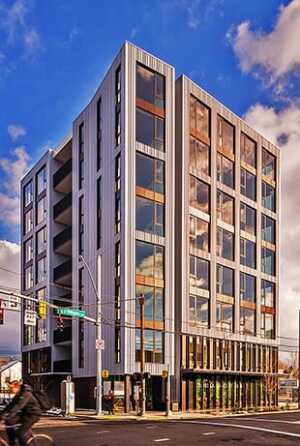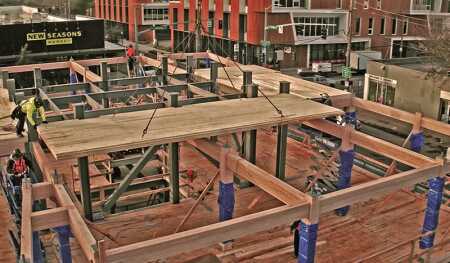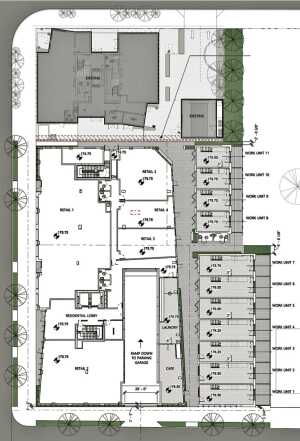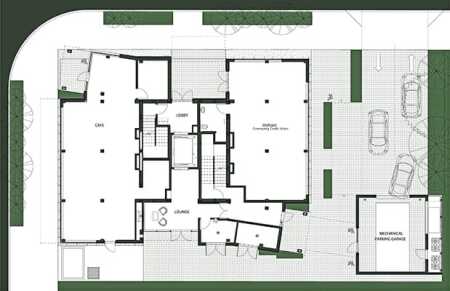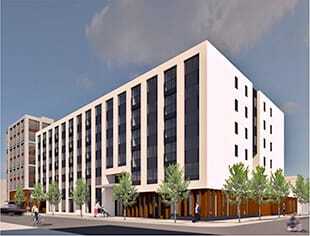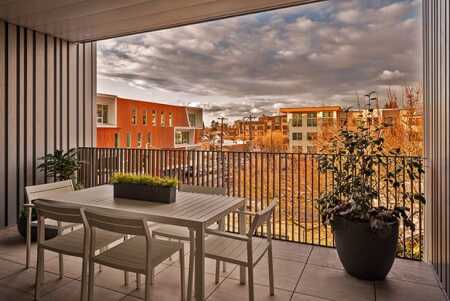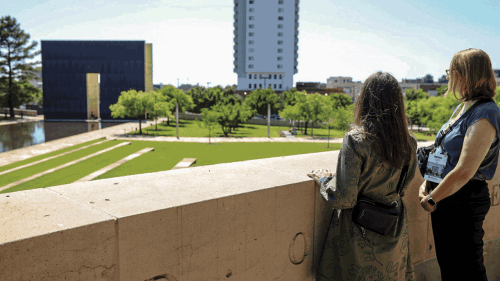Until recently, buildings taller than five stories had to be constructed of steel or reinforced concrete, both of which require about 80 percent more energy to produce and represent about 200 percent more greenhouse gas emissions than cross-laminated timber (CLT), a new engineered wood product.
Portland developer Ben Kaiser of the Kaiser Group recently completed the tallest American CLT mass timber building—an eight-story, 16-unit condominium/retail tower on an 8,470-square-foot (787 sq m) lot. (Another tower rising in Portland will soon surpass that height.) Residents enter the building—designed with only two units per floor—directly from an elevator into their own units. Light and ventilation from three directions around the condo units give them more the feeling of a house than of an apartment. The combination of exposed CLT wooden ceilings and exposed glulam posts and beams on a 12-by-12-foot (3.7 sq m) and 12-by-15-foot (3.7 by 4.6 m) grid, along with oak floors, lends a warm wooden patina to the units offset by vertical white drywall panels between the windows around the unit and in the kitchens and the bathrooms.
With two retail units on the ground floor for lease to a café and a credit union, and an 85-foot (26 m) zoning height limit, only 14 residential units could be included in the tower. Therefore, they needed to be large enough to attract an exclusive market, yet small enough to be affordable to that new market for Portland’s east side. Kaiser settled on 1,551-square-foot (144 sq m) two-bedroom, two-bathroom units in which one of the bedrooms could enlarge the central great room. Each unit has a 16.5-by-11.3-foot (5 by 3.5 m) deck facing north or south.
The building is called Carbon 12 for the most common carbon isotope the engineered wood sequesters, and for the building’s address at 12 NE Fremont Street in Portland. Typically, CLT panels are made of five layers of wood glued at right angles to one another under high pressure to form solid panels usually measuring about 12 feet wide and up to 60 feet long (3.7 by 18 m) and two to 24 inches (5 to 60 cm) thick. CLT enables developers to create tall, strong, energy-efficient, and earthquake- and fire-resistant buildings. CLT is made from sustainably managed forests from logs under nine inches (23 cm) in diameter. An acre (0.4 ha) of forest can absorb and sequester twice the carbon dioxide produced by the average car driven for a year.
The Structure
Carbon 12 is designed, metaphorically, like a tree. Its roots are a forest of steel piles driven 45 feet (14 m) deep into the ground to secure resistance to seismic pressures below and to wind loads above. The piles support a three-dimensional grid of glulam posts and beams onto which CLT panels measuring 37 by 11 feet (3 by 11 m) are lifted and locked into place. Plywood splines bind these panels to form an exceptionally solid diaphragm. Structurlam Mass Timber Corporation, based in Penticton, British Columbia, Canada, prefabricated the large CLT panels and glulam posts and beams. Tolerances were so tight that an entire floor was lifted by a crane and locked into place in less than five days.
Ceilings are 9.5 feet (2.9 m) high and the Douglas fir lower layer of the CLT panels is exposed. To prevent the transmission of sound between units, the same CLT panels cannot be exposed as floors of the units above. Instead, they are coated with 1.5 inches (3.8 cm) of gypcrete, a lightweight concrete floated into place on top of which are 1.5 inches (3.8 cm) of sound insulation board and a one-eighth-inch (3.1 mm) rubber mat under engineered oak flooring.
Advantages of CLT
Kaiser found the following reasons to experiment with a tower built with CLT panels:
- They match steel and concrete in structural performance, but are only 20 percent of their weight and allow for the use of smaller cranes.
- The panels thermally outperform concrete and steel.
- They are seismically resilient.
- Panels are prefabricated off site during foundation construction and are shipped for just-in-time scheduling, reducing the need for on-site storage.
- Using CLT can shorten construction schedules by up to 40 percent, reducing construction loan interest and land carrying costs, allowing units to be sold or rented earlier, which increases absorption and cash flow.
Zoning Negotiations
Carbon 12 is the first phase of a larger project. Starting in 2004, Kaiser bought seven lots to aggregate 1.1 acres (0.5 ha) of land just southeast of his earlier Radiator office and retail project and just west of a new grocery store. Those projects in inner northeast Portland helped the area change from its former character as a low- and moderate-income area comprising single-family houses into a trendy area of mixed-use buildings.
Kaiser’s land was zoned R2, which is a multifamily zone allowing one unit per 2,000 square feet (186 sq m), which would have allowed 22 to 32 units per acre (55 to 80 per ha). For a mixed-use structure, Kaiser sought a zone change to EX, a central employment zone allowing for a full range of high-density commercial, light industrial, institutional, and residential uses at least 65 feet (20 m) high. The Eliot Neighborhood Association (ENA) protested the project’s compatibility with the existing predominantly single-family neighborhood but did agree to a change to RX, a high-density residential zone that actually allowed residential buildings up to 100 feet (30 m) high and over 100 units per acre (247 per ha), limits the ENA later protested.
At the city council meeting ruling on the zone change, Kaiser offered to step the height limits down to 85 feet (26 m) on the northwest corner, to 65 feet (20 m) in the center, and to 45 feet (14 m) at the eastern property lines. “In the course of five minutes, we threw out a $100,000 zone change—all the studies, all the architectural drawings, all the work done by the city, the planners—and settled on what it is now,” Kaiser says. “This is what allowed us to explore tall timber because that corner was preserved at 85 feet.”
Site Design
The design for the larger site was a function of both the outsized 240-by-600-foot block (73 by 183 m)—deviating from Portland’s 200-by-200-foot blocks—and the varied zoning permitted within it. The 85-foot (26 m) height limit applied only to the small 70-by-121-foot (21 by 37 m) northwest corner tax lot that houses the tower, so Kaiser designed the tallest building he could using the CLT tower like a campanile (a freestanding bell tower in Italian towns) announcing the center of a transforming urban mixed-use neighborhood in close-in Portland.
For the remainder of the site, Kaiser designed a six-story, 110,000-square-foot (10,000 sq m) mixed-use project called Canyons with a 70-unit elder housing building, also built using CLT panels, next to a 17-unit retail component that he calls Makers’ Alley with small, affordable spaces for Portland’s burgeoning artisanal and small-craft industries. Eleven of those units are to be only one story, neighboring the single-family houses there. Including retail units, the CLT buildings on the whole site achieve a density of 94 units per acre (235 units per ha).
Robotic Parking
To sell high-end condominiums at premium prices to buyers who almost certainly would own cars, Kaiser needed to provide enough parking. On a site as small as the tower’s, building underground parking would have required underground ramps steeper than the code allowed or which spiraled so much as to have yielded too few spaces. Besides, the CLT tower’s small-grid, deep piling would have interfered with parking. So, Kaiser experimented with an automated underground parking system made by Wohr GmbH, a company based in Friolzheim, Germany. While mechanical parking lifts have been installed in Portland, this is the first fully robotic parking system in Oregon.
The Wohr Levelparker 590 model robotic system was designed for small-footprint areas. Carbon 12’s installation houses 22 cars in a 1,953-square-foot, 93-by-21-foot (181 sq m, 28 by 6 m) space. That is less than 90 square feet (8 sq m) per space—only about 20 percent of the space provided in a traditional parking structure. Residents drive into a 456-square-foot (42 sq m) single-car garage onto a pallet. After getting out of the car, residents enter a code into a keypad to lower the pallet onto a turn-table—which rotates the car for easy exiting—on the upper of two underground levels. The system then moves like a horizontal Ferris wheel to place the pallet into a storage location. When residents order retrieval, the system cycles the conveyor to deliver the car pallet to the entry lift where it rises to the garage, pointing outward, and the resident can drive off. Unlike conventional parking structures, no special ventilation, lighting, or security is required; no elevators, stairs, or fire exits are needed to move patrons; cars are safe from damage, theft, and vandalism; and no vehicle emissions can seep into the building above.
The robotic system cost $1.1 million to install, which comes to $50,000 per space. In addition, 43,000 cubic feet (1,200 cu m) of soil was excavated between the pilings to build the concrete vault to house it. If costs were isolated for the excavation and concrete vault, Kaiser thinks that might have added another $20,000 per space. He allocated these expensive spaces at one per unit for the six units on the three lower floors, and two per unit to the eight units on the upper four floors.
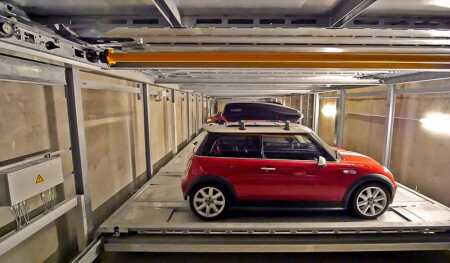
The robotic parking system stores 22 cars on two underground levels. Unlike parking structures, no special ventilation, lighting, or security is required; no elevators, stairs, or fire exits are needed to move patrons; cars are safe from damage, theft, and vandalism; and no vehicle emissions can seep into the building above. (Harding Steel)
Market
Kaiser thought the market for this small number of higher-end condos would be downsizing baby boomers and other empty-nest couples who appreciate close-in urban living in a trendy area. Dual-income younger professional couples also might be prime targets. But in the first three months, seven of the 14 units were sold or pending to single, middle-aged professional women, who perhaps were attracted by direct-elevator access to units and the security of the parking system. All but one unit sold were on the three lowest floors, and were priced from $730,000 to $795,000. Prices on the top four floors ranged from $1.1 million to $1.35 million. This is unusual for the west side of Portland, where the highest-priced units at the tops of buildings are often among the first to sell.
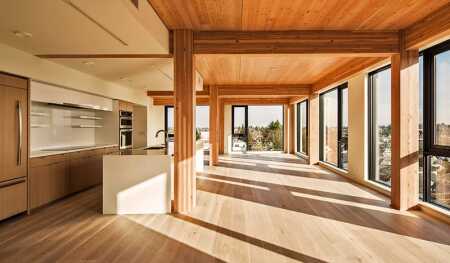
Above: The combination of exposed CLT wooden ceilings and exposed glulam posts and beams on a grid with oak floors lends a warm wooden patina to the units, offset by vertical white drywall panels between the windows on the three sides of the unit and in the kitchens and bathrooms. Below: Each unit has a 16.5-by-11.3-foot (5 by 3.5 m) deck facing north or south. (Andrew Pogue)
Economics
Pioneering the tallest CLT building in the nation, and the first robotic parking system in Oregon, at premium prices on a single-family-house-sized lot, on a block where 1,000-square-foot (93 sq m) houses predominate, takes courage.
Kaiser says the total development cost was about $14.5 million, almost $600 per square foot ($6,500 per sq m) for salable/leasable area. But Kaiser has structured his business with multiple roles and profit centers as architect (through his firm Path Architecture), as developer and general contractor (through his firm Kaiser Group), and marketing and sales through Windermere, his wife’s firm. He obtained a construction loan of $10.3 million from Columbia Bank and provided about 30 percent equity. It also helped that he acquired and assembled the land for under $20 per square foot ($217 per sq m), a fraction of current values.
With sales averaging about $655 per square foot ($7,100 per sq m) and commercial leasing rates at $33 per square foot ($360 per sq m) triple-net, the high cost of developing innovative projects in Portland may trim profit margins. But with the learning curve for CLT buildings now completed, the developer’s low land cost basis, and a larger number of units to offset costs in the Canyons phase ahead, Kaiser may have advanced environmental stewardship for CLT mass timber buildings in an economically and environmentally sustainable way.
WILIAM P. MACHT is a professor of urban planning and development at the Center for Real Estate at Portland State University in Oregon and a development consultant. (Comments about projects profiled in this column, as well as proposals for future profiles, should be directed to the author.)

